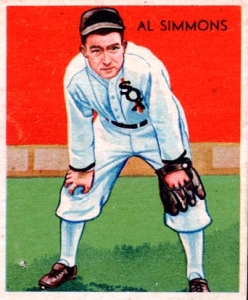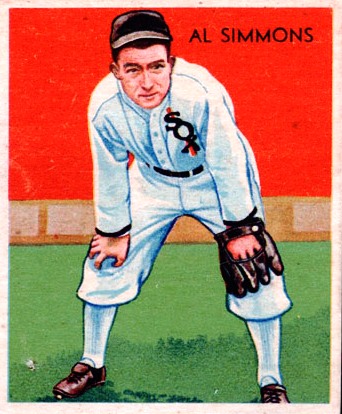July 10, 1926: Violent vicissitudes as A’s rally to beat White Sox, 17-14
 Philadelphia is not known the to be coolest place to summer in, and the summer of 1926 was no exception. Temperatures had been rising steadily after a rainy fourth of July and reached 94 degrees on July 9 with a forecast for even warmer weather on July 10.1 The weather was having a tragic effect on the city. The death toll from the heat wave had reached six people on the 10th as the Athletics faced the Chicago White Sox in the third game of a four-game series. The A’s had entered the series a half-game behind the White Sox in second place behind the New York Yankees, but after two one-run victories the A’s had passed the White Sox and were 7½ games behind the Yankees.
Philadelphia is not known the to be coolest place to summer in, and the summer of 1926 was no exception. Temperatures had been rising steadily after a rainy fourth of July and reached 94 degrees on July 9 with a forecast for even warmer weather on July 10.1 The weather was having a tragic effect on the city. The death toll from the heat wave had reached six people on the 10th as the Athletics faced the Chicago White Sox in the third game of a four-game series. The A’s had entered the series a half-game behind the White Sox in second place behind the New York Yankees, but after two one-run victories the A’s had passed the White Sox and were 7½ games behind the Yankees.
Starting for the White Sox on this steamy day was Ted Blankenship, who came into the game with a 10-7 record after shutting out the Cleveland Indians on July 6. Opposing Blankenship was future Hall of Fame pitcher Lefty Grove who had last pitched on July 5, when he beat the Yankees in game one of a doubleheader and got a three-inning save in game two. Grove’s record coming into the game was only 9-8, but his ERA was a microscopic 1.81. He would go on to lead the American League in ERA in 1926 with a mark of 2.51, but this game did not help. Perhaps because of the heat, this was one of the worst efforts of the year for both pitchers.
There would be no scoring in the game until the fourth inning but the A’s had some chances early. In the first inning, one-out singles had runners on the corners for Bill Lamar. Walt French tried to score on Lamar’s fly ball to center, but Johnny Mostil cut him down at the plate to keep the game scoreless. The A’s had two runners on in the third as well, but Lamar struck out to end that frame. The third inning was the last to have no runs scored until the ninth, leading to what sportswriter James C. Isaminger described in the Philadelphia Inquirer as “an afternoon of violent changing vicissitudes.”2
The fun started for Philadelphia in the bottom of the fourth. Four consecutive singles by Jimmy Dykes, Jim Poole, Mickey Cochrane (one RBI), and Chick Galloway (two RBIs) made the score 3-0 before the first out was recorded. Grove recorded the first out with a sacrifice, and then Max Bishop plated Galloway with the fifth single of the inning. After a popout, Al Simmons took a different path to scoring runs this inning with a home run, and the A’s had a commanding 6-0 lead. The heat of the day finally got to Grove in the top of the fifth, as a walk, singles by Bill Barrett and Willie Kamm, and a groundout by Johnny Grabowski cut the deficit to 6-2. After a groundout, doubles by Mostil and Bill Hunnefield brought the White Sox back two runs closer at 6-4.
Sloppy Thurston, who had pinch-hit for Blankenship in the top of the fifth, took the hill for the White Sox in the bottom of the inning but didn’t stay long. Dykes led off the inning again, this time with a double. Poole moved Dykes to third with a groundout, and Cochrane’s triple brought him home. When Galloway’s single scored Cochrane, White Sox manager Eddie Collins decided that Thurston had seen enough action for the day, and brought in Sarge Connally to shut down the rally, which he did, but only after allowing a single to pinch-hitter Sammy Hale that scored Galloway and at 9-4 restored most of the A’s lead.
The White Sox got all of those runs back in the top of the sixth without a hit. Bibb Falk’s grounder was booted by Dykes, and Earl Sheely drew a base on balls from Sam Gray, who had relieved Grove to start the inning. Barrett followed with a slow roller to Galloway, whose wild throw to right field allowed both runners to score and Barrett to get to third, where he scored on another grounder to Galloway, making it a 9-7 game.
On this day, no lead or comeback was safe. The A’s upped their lead to 11-7 in the bottom of the sixth but ran themselves out of a potential big inning. After a leadoff groundout, Dykes walked and Poole doubled, and after Cochrane was walked intentionally, the bases were loaded. The light-hitting Galloway (who entered the game averaging .218) atoned for his earlier error with a single to right that scored Dykes and Poole. Cochrane decided to test Barrett’s arm by trying for third, and Barrett passed the test by throwing him out. Galloway, with the play in front of him, went for second and was thrown out as well, making it an unusual right field-to third base-to shortstop double play that also scored two runs. Galloway’s five RBIs in the game were a career high.
The White Sox had spent the last couple of innings getting themselves off the deck and did so again in the seventh. Mostil and Hunnefield led off the inning with singles and both scored on Falk’s double that also ended Gray’s afternoon. Joe Pate replaced Gray and allowed a double to Kamm that cut the A’s lead to 11-10. In the bottom of the inning, Connally did what the 30,000 in attendance must have thought was impossible by retiring the A’s without allowing a run, setting up the pivotal eighth inning.
Collins selected White Sox pitcher Ted Lyons to pinch-hit for Connally to lead off the eighth. Lyons was one of the better hitting pitchers in baseball, but he struck out to open the inning.3 Mostil followed with a single and Collins singled to put the tying and lead runs aboard. Falk put the White Sox in the lead with his sixth home run of 1926, giving him five RBIs for the game.4 Sheely followed with another home run and the White Sox now led, 14-11. The vicissitudes were not done yet, though.
Even though Lyons pinch-hit for the pitcher in the top of the eighth, Collins selected Red Faber to pitch the bottom of the inning. Faber hadn’t pitched since a complete-game 7-2 win over the Detroit Tigers on July 4, but was not right on this day. Lamar led off with a double, and after Dykes grounded out, Poole hit a ball to Kamm, who tried and failed to get Lamar at the plate. Cy Perkins walked, putting the tying runs on base for Joe Hauser, whose double tied the game, 14-14, and ended Faber’s day earlier than Collins expected. Milt Steengrafe relieved Faber, but the relief was all for the A’s as he walked Bishop and hit French to load the bases. Simmons’s double to left put the A’s back in front, 16-14. Next Steengrafe walked Lamar and hit Dykes to push French home with the Athletics’ 17th and final run of the afternoon. Poole popped up to short to end the inning, but the damage was done.
The White Sox tried to rally one more time, against the fifth Athletics pitcher of the game, Rube Walberg, and had the tying run at the plate after Kamm and Harris singled two put two runners on with one out, but neither Mostil nor Hunnefield could be the hero, and the game ended 17-14. The 17 runs were the most the A’s scored in a game in 1926, matching a 17-15 affair against the Cleveland Indians in 1925. The 17 runs were also the most the White Sox allowed in a game in 1926; it was only the third time since 1908 that they scored 14 runs and lost.5 After an off day, the White Sox avoided a series sweep on July 12 by beating the A’s 8-6, with Blankenship recovering from his beating to earn a 3⅔-inning save for Lyons, his only save in 1926 and the last of his career.
SOURCES
In addition to the sources cited in the Notes, the author accessed Retrosheet.org, Baseball-Reference.com, SABR’s BioProject via SABR.org, The Sporting News archive via Paper of Record, the New York Times archives, and the Chicago Tribune and Philadelphia Inquirer via newspapers.com.
NOTES
1 Historical weather data provided by the Franklin Institute, ffi.edu.
2 James C. Isaminger, “Athletics Capture Weird Contest From Eddie Collins’ Crew,” Philadelphia Inquirer, July 11, 1926: 43.
3 In the years Lyons was active (1923-1942), only Red Ruffing (503), Bob Smith (409), and Bucky Walters (386) had more hits that Lyons’ 364.
4 Falk won the White Sox triple crown in 1926 with 8 home runs, 108 RBIs, and a .345 batting average.
5 The White Sox lost 16-15 decisions to the Tigers on June 18, 1911, and June 2, 1925.
Additional Stats
Philadelphia Athletics 17
Chicago White Sox 14
Shibe Park
Philadelphia, PA
Box Score + PBP:
Corrections? Additions?
If you can help us improve this game story, contact us.


